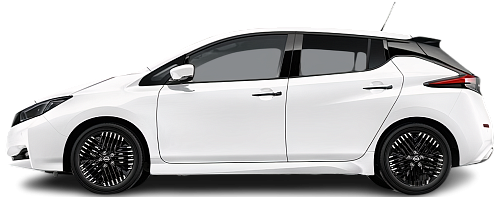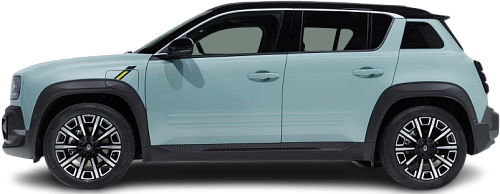Global EV Comparison: Nissan Leaf 40 kWh vs Renault 4 E-Tech EV52 150hp
Struggling to Decide? Let AI Help!
Your AI Summary Is Ready!
General Info
The Renault 4 E-Tech EV52 150hp (2025-...) is announced, but not yet in production. The Nissan Leaf 40 kWh (2022-2025) has been discontinued. You can find it for as low as €15890 on the used car market.
The two vehicles share the same body style: Hatchback.
| Property | Nissan Leaf 40 kWh | Renault 4 E-Tech EV52 150hp |
|---|---|---|
| Years of Production | 2022-2025 | 2025-… |
| Current Status | Discontinued | Announced |
| Country of Manufacture | Japan, UK, USA | France |
| Body Style | Hatchback | Hatchback |
| Market Availability | EU, USA | EU |
| Price Europe (New) | - Price Europe (New) | €32400 |
| Price Europe (Used) | €15890 | - Price Europe (Used) |
| GCC Score | 4.8 | 5.6 |
Range and Efficiency
The Renault 4 E-Tech EV52 150hp (2025-...) boasts a greater real-world range, a larger battery, and superior energy efficiency compared to the Nissan Leaf 40 kWh (2022-2025).
| Property | Nissan Leaf 40 kWh | Renault 4 E-Tech EV52 150hp |
|---|---|---|
| Range (EPA) | 240 km | - Range (EPA) |
| Range (WLTP) | 285 km | 409 km |
| Range (GCC) | 238 km | 348 km |
| Battery Capacity (Nominal) | 40 kWh | 55 kWh |
| Battery Capacity (Usable) | 39 kWh | 52 kWh |
| Efficiency per 100 km | 16.4 kWh/100 km | 14.9 kWh/100 km |
| Efficiency per kWh | 6.1 km/kWh | 6.69 km/kWh |
| Range and Efficiency Score | 5.5 | 7.1 |
Charging
Both vehicles utilize a standard 400-volt architecture.
The Renault 4 E-Tech EV52 150hp (2025-...) offers faster charging speeds at DC stations, reaching up to 100 kW, while the Nissan Leaf 40 kWh (2022-2025) maxes out at 50 kW.
The Renault 4 E-Tech EV52 150hp (2025-...) features a more powerful on-board charger, supporting a maximum AC charging power of 11 kW, whereas the Nissan Leaf 40 kWh (2022-2025) is limited to 3.6 kW.
| Property | Nissan Leaf 40 kWh | Renault 4 E-Tech EV52 150hp |
|---|---|---|
| Max Charging Power (AC) | 3.6 kW | 11 kW |
| Max Charging Power (DC) | 50 kW | 100 kW |
| Architecture | 400 V | 400 V |
| Charge Port | CHAdeMO | CCS Type 2 |
| Charging Score | 3.3 | 5.5 |
Performance
Both vehicles are front-wheel drive.
Both cars offer the same motor power, but the Nissan Leaf 40 kWh (2022-2025) achieves a faster 0-100 km/h time.
| Property | Nissan Leaf 40 kWh | Renault 4 E-Tech EV52 150hp |
|---|---|---|
| Drive Type | FWD | FWD |
| Motor Type | PMSM | EESM |
| Motor Power (kW) | 110 kW | 110 kW |
| Motor Power (hp) | 148 hp | 150 hp |
| Motor Torque | 320 Nm | 245 Nm |
| 0-100 km/h | 7.9 s | 8.2 s |
| Top Speed | 144 km/h | 150 km/h |
| Performance Score | 3.1 | 2.9 |
Dimensions
The Nissan Leaf 40 kWh (2022-2025) is longer, but has a similar width and height to the Renault 4 E-Tech EV52 150hp (2025-...).
The Nissan Leaf 40 kWh (2022-2025) boasts a more extended wheelbase.
| Property | Nissan Leaf 40 kWh | Renault 4 E-Tech EV52 150hp |
|---|---|---|
| Length | 4490 mm | 4144 mm |
| Width (with Mirrors) | 2030 mm | 2020 mm |
| Width (w/o Mirrors) | 1788 mm | 1808 mm |
| Height | 1530 mm | 1552 mm |
| Wheelbase | 2700 mm | 2624 mm |
Cargo and Towing
The Nissan Leaf 40 kWh (2022-2025) features a larger trunk, but the Renault 4 E-Tech EV52 150hp (2025-...) offers greater maximum cargo capacity when the rear seats are folded.
Neither car is equipped with a frunk (front trunk).
The Renault 4 E-Tech EV52 150hp (2025-...) has a towing capacity of up to 750 kg, whereas the Nissan Leaf 40 kWh (2022-2025) is not officially rated for towing in the EU.
| Property | Nissan Leaf 40 kWh | Renault 4 E-Tech EV52 150hp |
|---|---|---|
| Number of Seats | 5 | 5 |
| Curb Weight | 1580 kg | 1462 kg |
| Cargo Volume (Trunk) | 435 l | 420 l |
| Cargo Volume (Max) | 1176 l | 1405 l |
| Cargo Volume (Frunk) | - Cargo Volume (Frunk) | - Cargo Volume (Frunk) |
| Towing Capacity | - Towing Capacity | 750 kg |
| Cargo and Towing Score | 4.5 | 4.6 |




